ZEN MESTEREK ZEN MASTERS
« Zen főoldal
« vissza a Terebess Online nyitólapjára
牧溪法常 Muqi Fachang / Muxi Fachang (1210?-1269?)
Wade-Giles: Mu- ch'i Fa-ch'ang; Japanese: 牧谿 Mokkei
http://en.wikipedia.org/wiki/Muqi_Fachang
http://www.360doc.com/content/14/0423/22/6650597_371549558.shtml
http://www.zhtdshy.com/famous/2014/0806/124.html
http://blog.sina.com.cn/s/blog_3e9eeaf60101hyil.html
http://www.npm.gov.tw/hotnews/9910seminar/download/en/A02.pdf
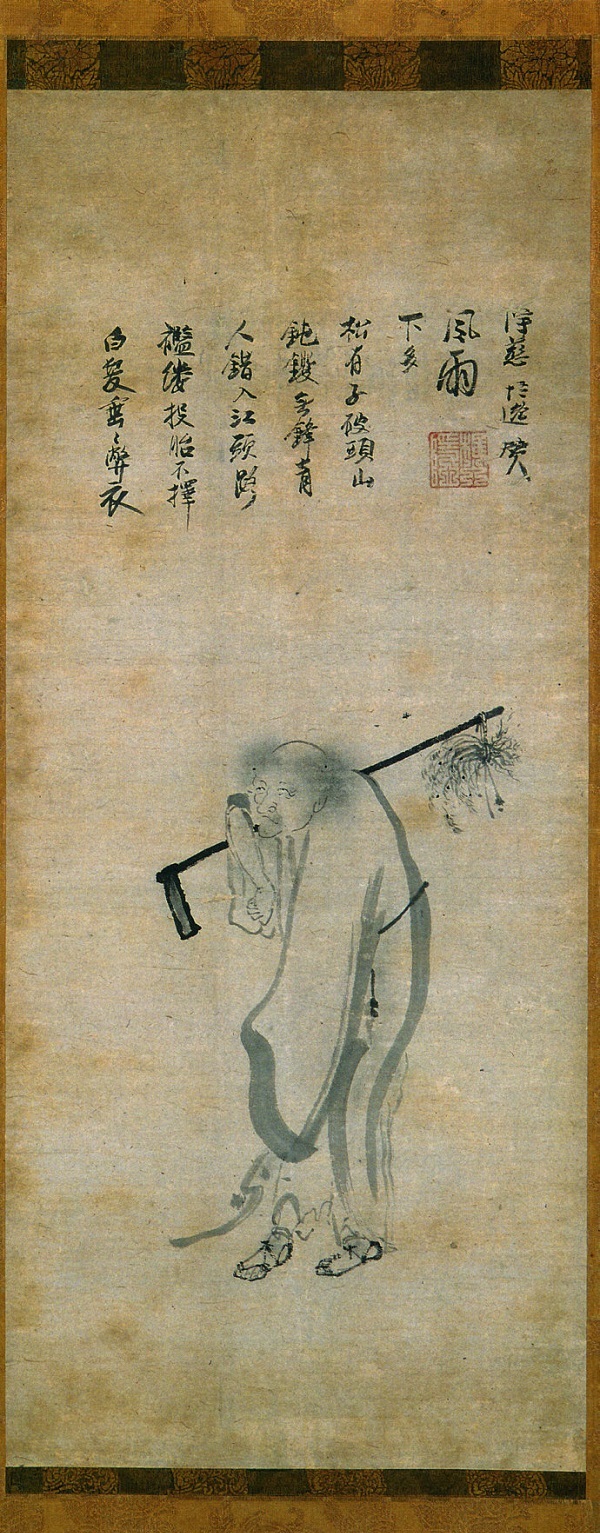
五祖荷锄图
The fifth Chan patriarch carrying a hoe. H. Marjeyama Collection. The poem referring to the motif, signed Wu-I.
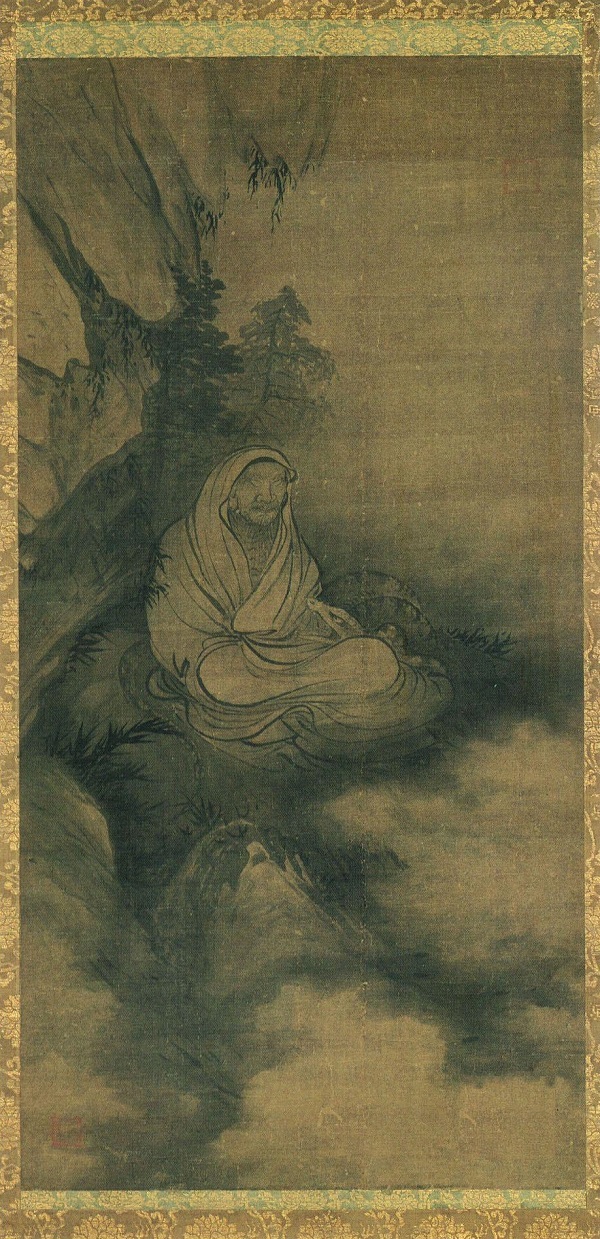
羅漢図
An arhat in meditation encircled by a snake
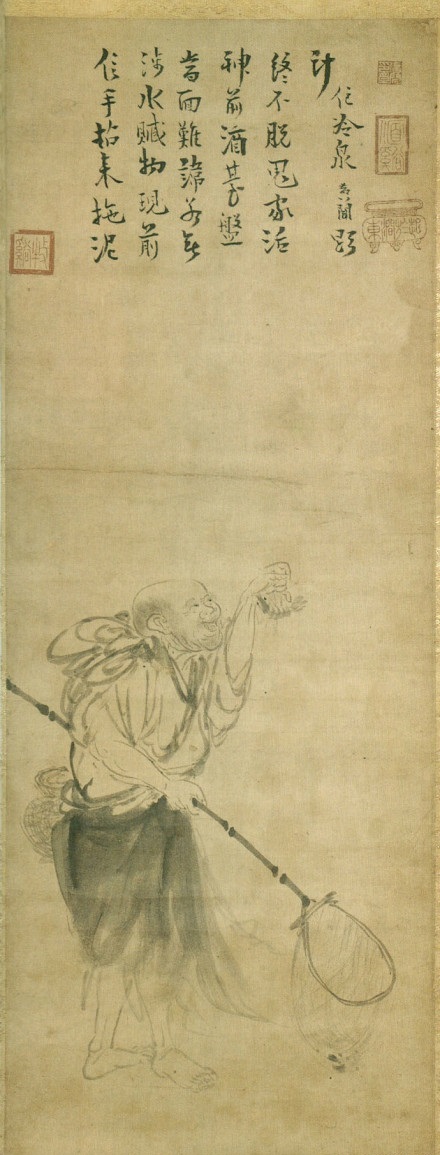
Master Clam 蜆子和尚
Muxi Fachang 牧谿法常 (13th century) Before 1256, Southern Song (1127-1279)
Encomium by Yanxi Guangwen 偃溪廣聞
(1189-1263)
Hanging scroll, ink on paper, 84.1 x 37.4
Private collection, Japan
Encomium:
Casually grasping what comes, dragging the mud and wading the water,
Illicit booty emerges before him, facing a tough taboo,
If the wine of tray is missing from before the gods,
Ultimately he has not cast off the handiwork of demons.
Inscribed by Guangwen, resident of the Cold Spring.
信手拈來,拖泥涉水, 贓物現前,當面難諱, 若無神前酒臺盤, 終不 脫 鬼家活計。 住冷泉廣聞題。
Chien-tzu is supposed to have been a disciple of Tung-shan Liang-chieh (807-869). He was not a Ch'an monk in the usual sense, however. Dressed in the same rags in summer and winter, he roamed the riverside with his fishing net in search of shrimps and clams, which formed his staple diet. At night he would sleep among the offerings of paper money made to the White Horse Shrine on Eastern Mountain. It was said that he attained Enlightenment while catching shrimp.
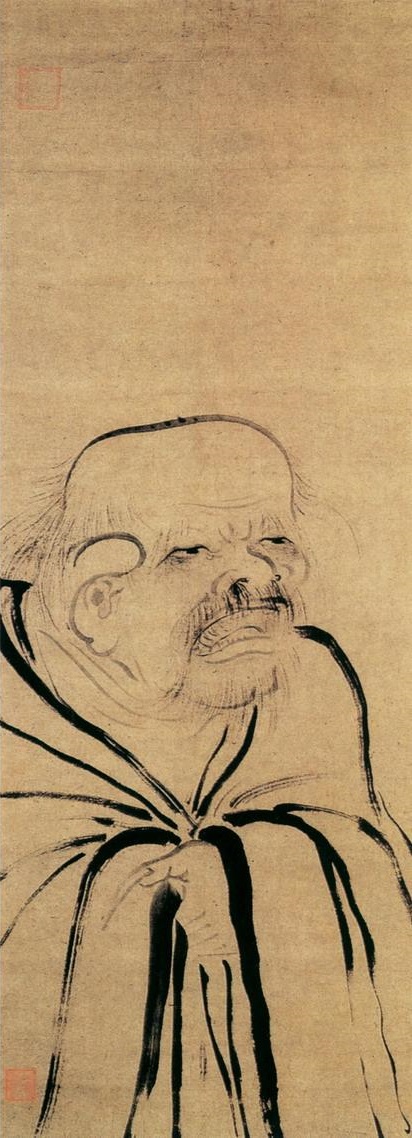
Laozi 老子圖
by
Muxi Fachang 牧溪法常 (13th century)
13th century, Southern Song (1127-1279)
Hanging scroll, ink on paper, 88.9 x 33.5 cm
Okayama Prefectural Museum of Art
National Treasure
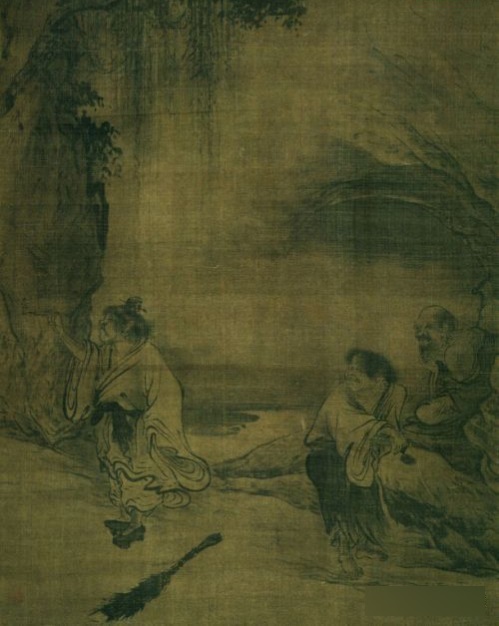
丰干寒山拾得图
Feng-kan, Han-shan, Shih-te
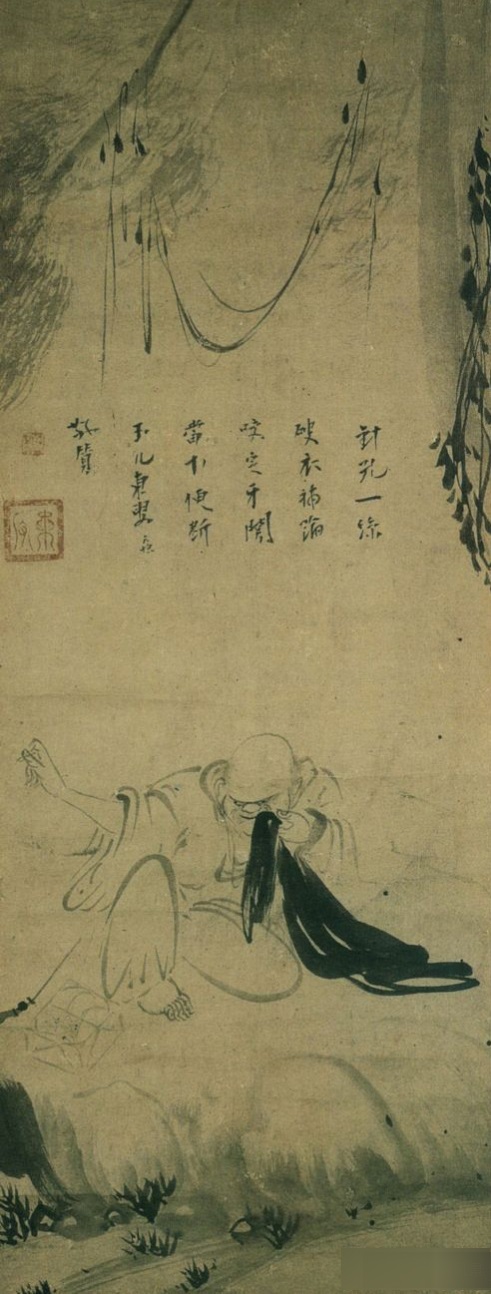
朝阳图`东叟元恺赞
A priest sewing his mantle. Count Date. Inscription by the monk Tung-sou, probably a Yuan painting.
Monk Mending Clothes in the Morning Sun 朝陽圖
Anonymous, traditionally attributed to Muxi Fachang 牧谿法常 (13th century)
Late 13th or early 14th century
Hanging scroll, ink on paper, 84.5 x 30.5 cm
Kyoto National Museum, AK 817
Encomium:
One thread passing through the eye of a needle,
Patches the holes in a tattered garment,
Biting down firmly with one's jaws,
Immediately it is broken.
Dongsou Yuankai at Yuji respectfully eulogises.
針孔一絲,破衣補漏。 咬定牙關,當下便斷。
玉几東叟元愷敬贊。
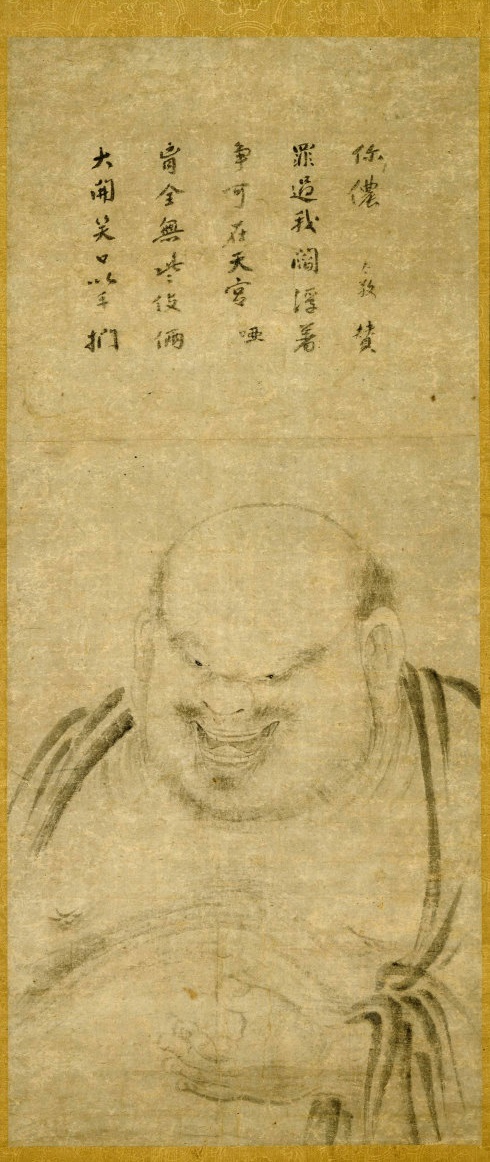
布袋图
Pu-tai
96,5 × 41,3 cm, Kyushu National Museum
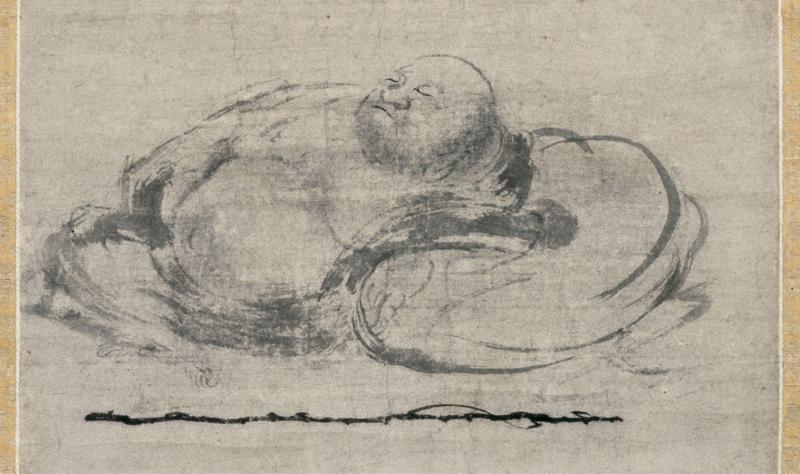
布袋図
Pu-tai
Slumbering Budai (detail). Attributed to Muqi.
Hanging scroll, ink on paper; 77.1 x 30.9 cm. Kyoto National Museum.
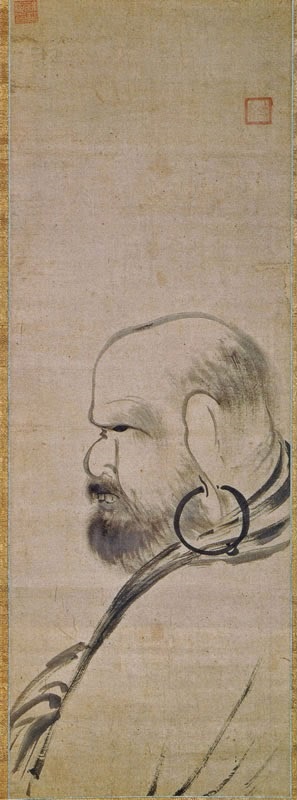
達磨図
Bodhidharma
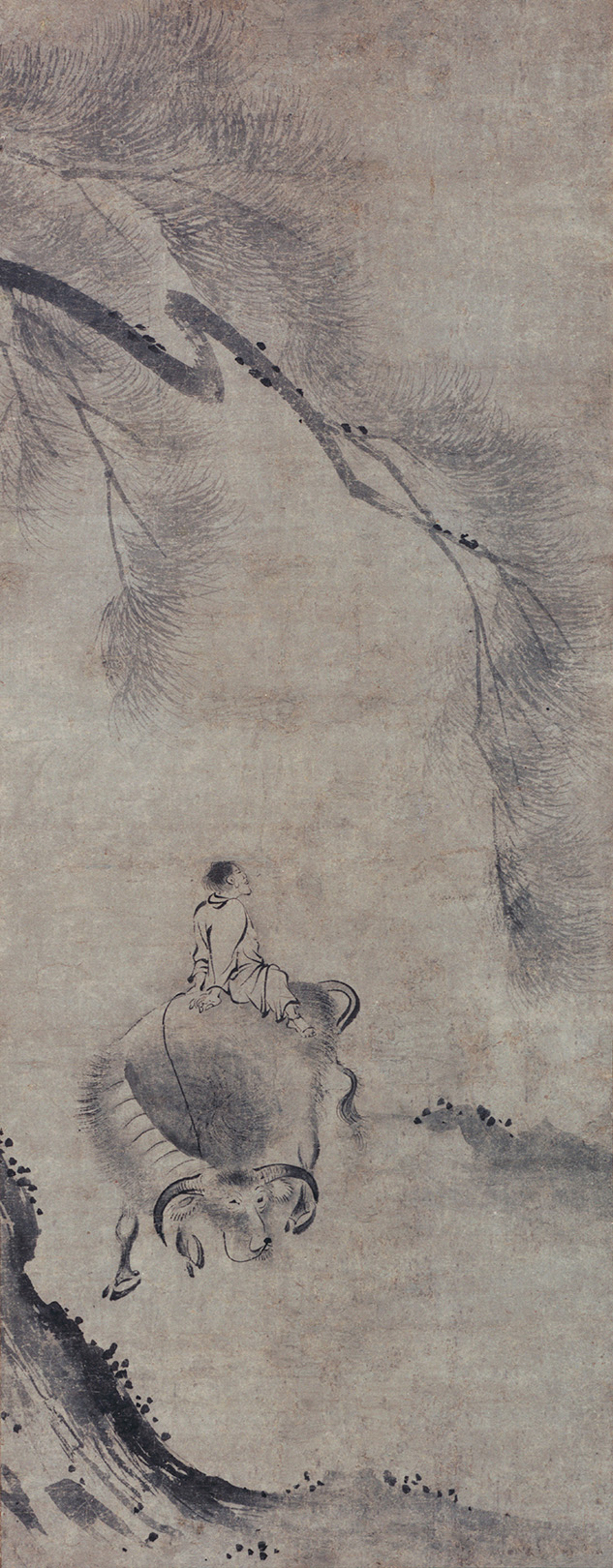
“Herdboy on Ox”
by Anonymous, Japanese 無款
(13th-14th century) Old attribution to Fachang Muqi (ca.1220-ca. 1280)
Hanging scroll, ink on paper
112.5 x 39.7 cm.
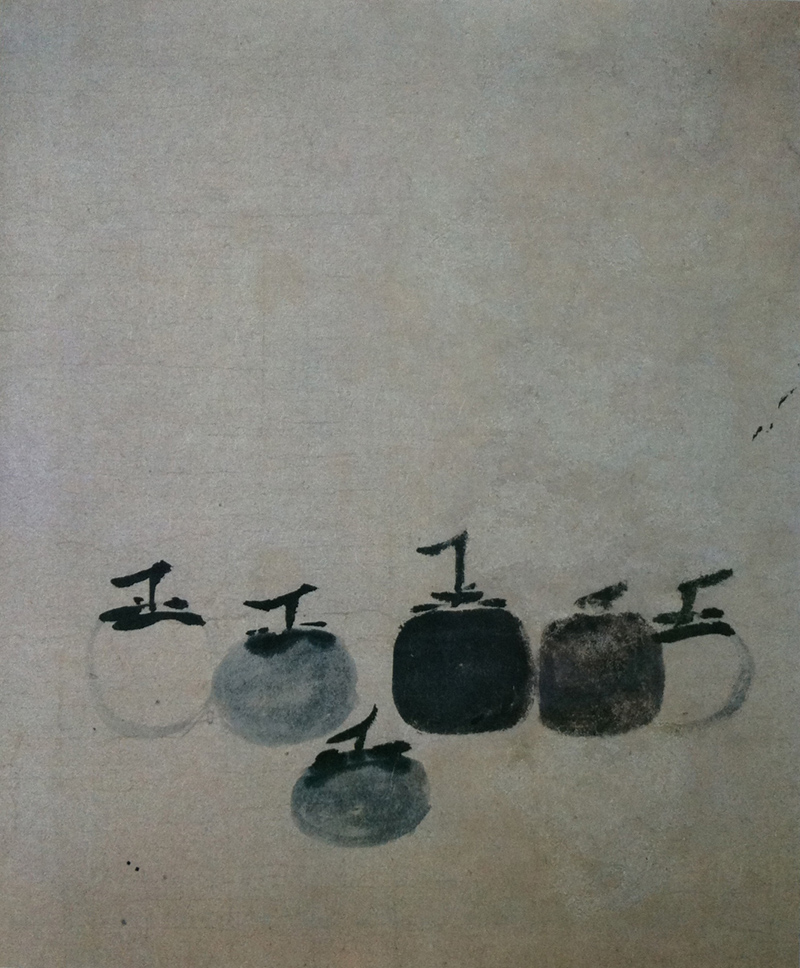
六柿圖
Persimmons
Album leaf, ink on silk, 31.1 x 29 cm, Daitoku-ji, Ryuko-in, Kyoto
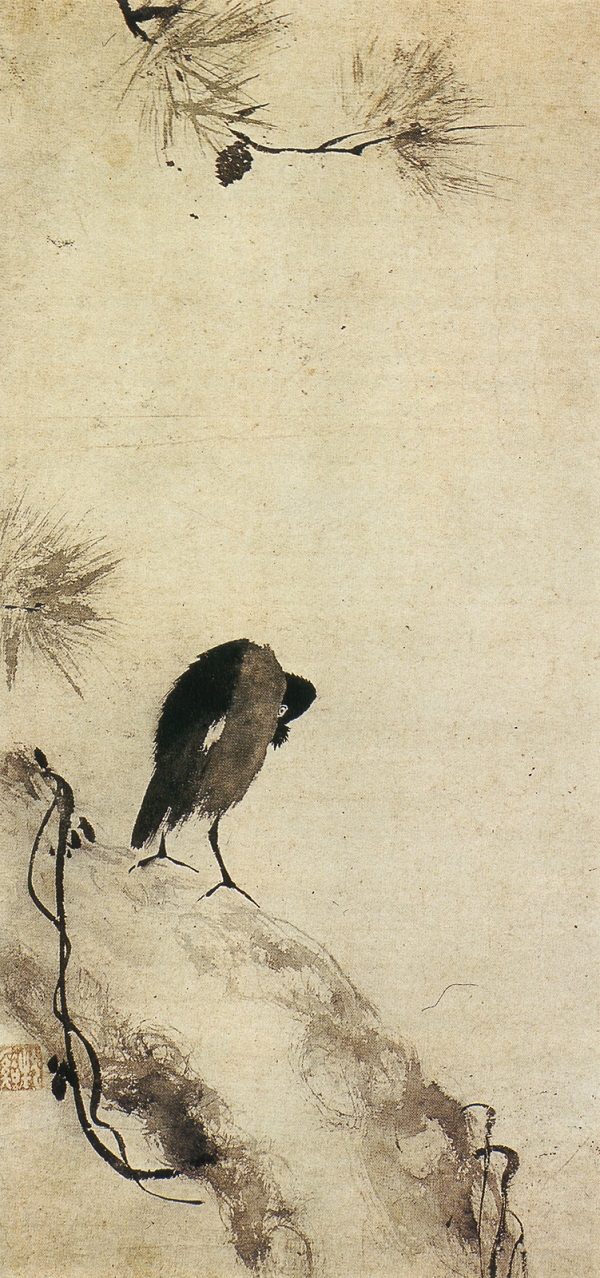
叭叭鳥圖
Mynah on the trunk of a pine tree
Daitokuji. Seal of the painter
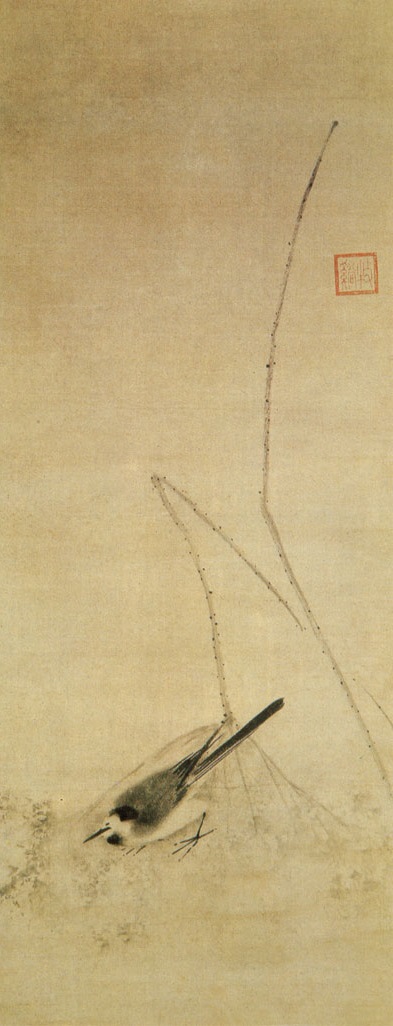
鸟荷图 轴
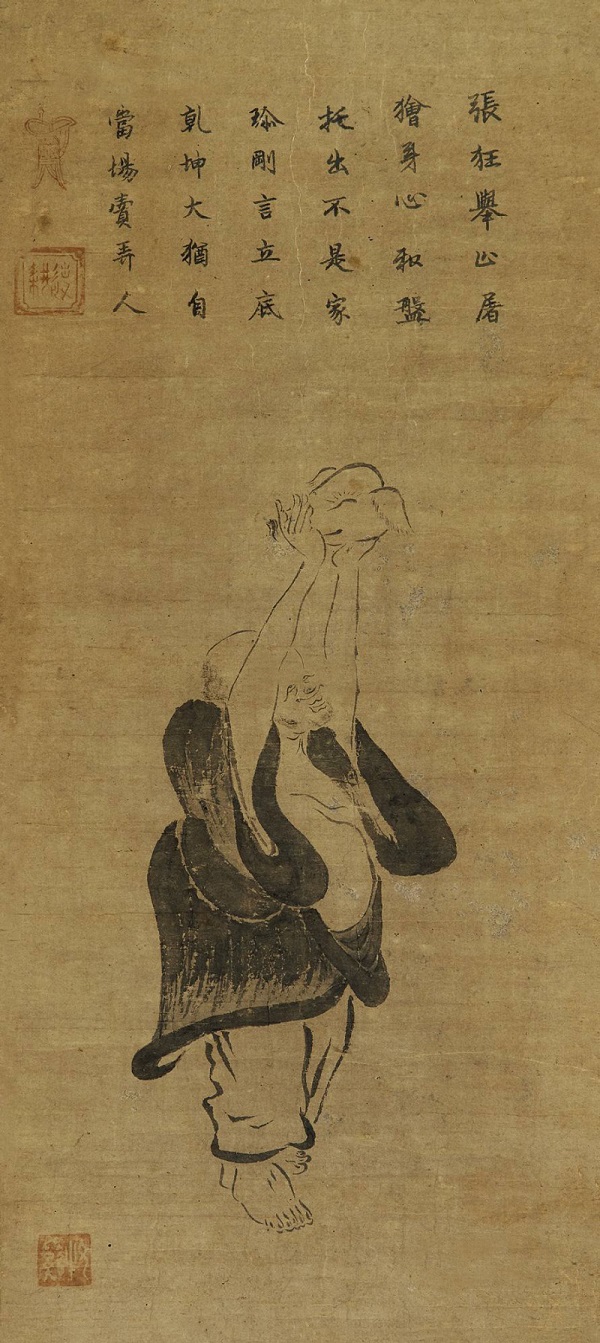
猪头和尚 Zhutou heshang
Monk "Pig's Head"
Seals:
退耕 (朱), 76 × 34 cm
The identity of Chu-t'ou is rather unclear. His name means pig's head and he is usually shown eating a pig's head or holding one in his hands. He is usually said to represent a certain Chih Meng-hsu who was fond of eating pig and was therefore called "Pig's Head." There is nothing in Chih's biography, however, that could justify his inclusion in the Ch'an pantheon of eccentrics. There are two other Ch'an stories, which possibly could be relevant to this theme.
The first concerns the monk Wen-shu Ssu-yeh who started his career as a butcher. One day, on the point of killing yet another pig, he suddenly realized the error of his ways in a flash of revelation. He quit his trade to become a monk and composed the following gatha on the occasion:
Yesterday the heart of a [blood thirsty] Yaksa,
Today the face of a Bodhisattva.
Between the Bodhisattva and the Yaksa
There is not a shred of difference.When he went to Master Tao of Wen-shu, who was to become his teacher, the Master asked him: "What did you see when you were about to slaughter that pig? What made you shave your head and depart on a pilgrimage?" Ssu-yeh thereupon made a gesture as if he were whetting his knife.
Another possibility is that the representation of "Pig's Head" was inspired by an anecdote from the life of P'an-shan Pao-chi (720-814), a pupil of the great Patriarch Ma-tsu Tao-i (died 788).One day he saw a man in the marketplace enter a butcher's shop to buy meat. He heard him ask: "Please cut me a catty of the finest." The butcher dropped his knife, picked it up again and said: "My dear sir, what do we have here that is not of the finest?" Upon hearing these words Pao-chi suddenly attained Enlightenment.
-from Zen Painting and Calligraphy by J. Fontein and M.L. Hickman
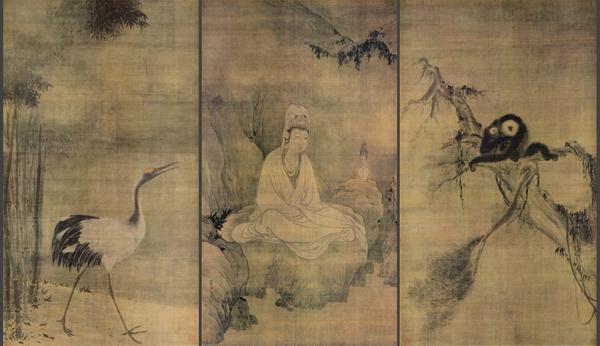
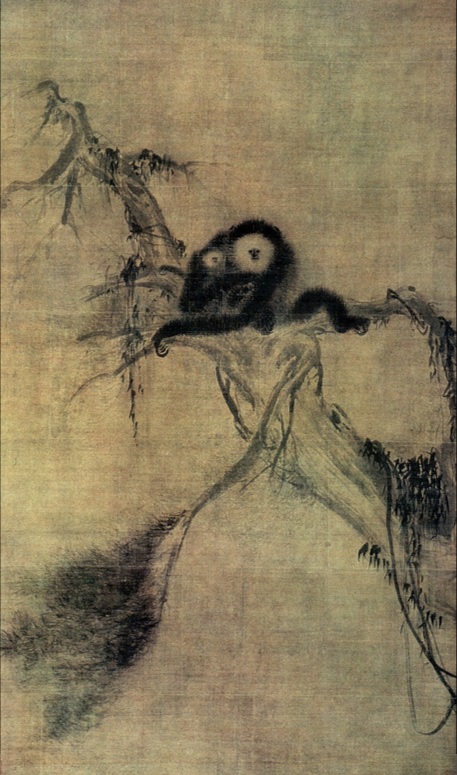
观音猿鹤图
A triptych
[sanpukutsui 三幅対]: (a) Kuan-yin; (b) Monkey with her baby on a pine branch; (c) Crane in a bamboo grove.
Daitokuji, Kyoto. Were probably combined after importation into Japan in the 14th century. Signed with the seal of the painter.
Cf. Le gibbon dans la civilisation chinoise - Robert van Gulik
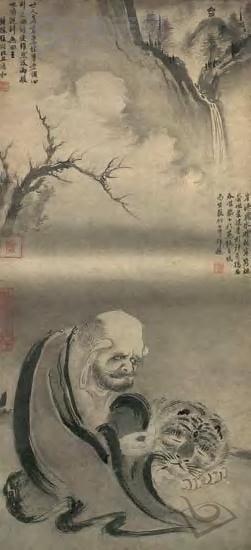
二祖调心图
The Second Patriarch in Contemplation
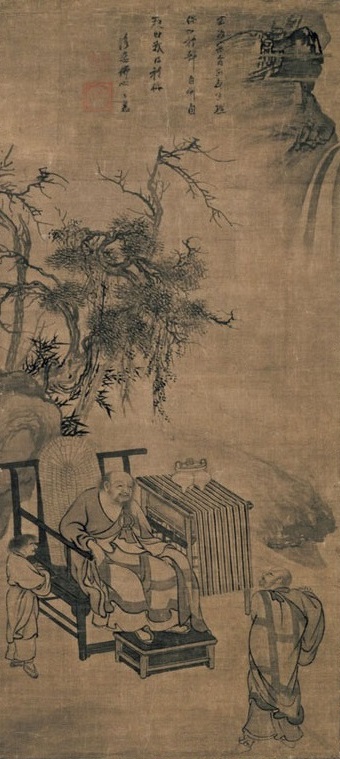
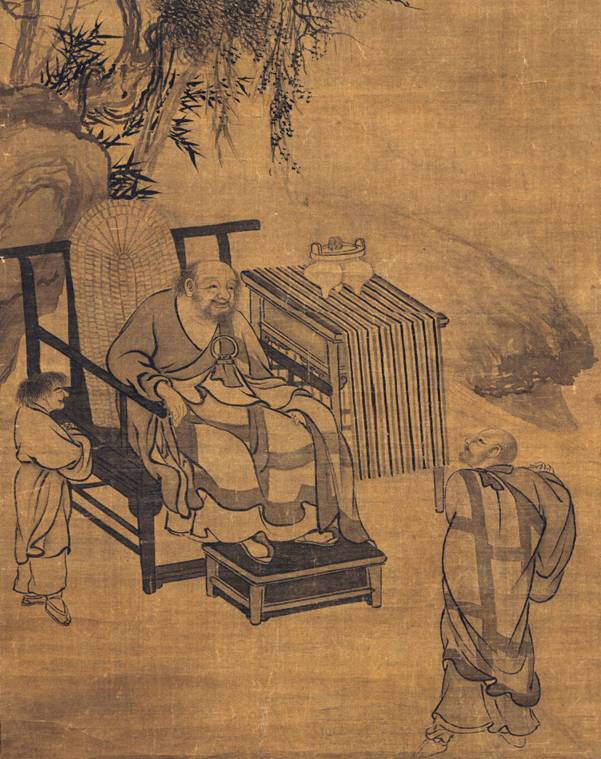
Xuefeng Receives his Student Xuansha 雪峰接玄沙生圖
Attributed to Muxi Fachang 牧谿法常 (13th century) Late 13th century, Yuan (1271-1368)
Encomium by Yuji Zhihui 愚極智慧 (act. 1298)
Hanging scroll, ink on silk, 102 x 46 cm
Kyoto National Museum, AK672
Important Cultural Property
Encomium:
Xuan Sha's teachings have no special rationale,
You pay obeisance to me, prostrating yourself and getting up,
As I pay obeisance to you.
[Signed] Jingci Foxin Zhihu.
玄沙宗旨, 別無道理, 你為禮拝, 自倒自起, 因我得禮你。 淨慈佛心,智慧。
List of the paintings attributed to the painter Mu Chi
· Priest Chien-tzu playing with a shrimp. Executed before 1260, date of Yen An's inscription. Baron Masuda. Kokka No. 122. A
· The poet Lu Yu walking with a staff. Ti Ping-tzu. Seals of the painter and of the Yuan emperor Wen-tsung. Chung-kuo I, 35. C
· A monk reading in the moonlight. Ueno. Inscription by the monk Ching-shan, pupil of Wu-chen, Kokka, No. 87. B?
· A priest sewing his mantle. Count Date. Inscription by the monk Tung-sou, probably a Yuan painting. Kokka, No. 314.
· The fifth Chan patriarch carrying a hoe. H. Marjeyama Collection. The poem referring to the motif, signed Wu-I. Toso, p. 114 B?
· A set of three: (a) Feng-kan with a tiger; (b) Sparrows on a bamboo branch; (c) Sparrows on a willow branch. seals of the painter, probably old imitations Formerly marquis Kuroda. B?
· Wei-to-lo in the guise of a rugged old man. Noda. Kokka, No. 425. C
· The Chan monk Hsuan-cho. Moriya, Kyoto. Probably a Yuan painting by a close follower. B?
· Han-shan the Chan monk. Owned by ? Inscription by Tao Lung (ca. 1245), a later picture. Soraikan II, plate 18. C
· The autumn moon. Prince Tokugawa Collection. Nagoya Museum. Siren #348. A
· The night rain. Baron Masuda. Siren #341. A
· The evening bell from a distant temple. Hakateyama. Shimbi No. Five. A
· Sails distant from the coast returning to port. Count Matsudaira. Kokka, No. 291. A
· The sunset on a fishing village. M. Nezu. Kokka, No. 340. A
· Wild geese lighting. Viscount Matsudaira. Kokka, No. 410. A
· Evening snow on the hills. Suenobu. Destroyed in the air raid on Sendai, Honshu, Japan, 1945. Sogen Meigashu II. A
· The evening bell. Yada in Katayamazu, Japan. Sogen Meigashu II.
· Misty river in spring with a ferry. Viscount Akimoto. Album leaf. Kokka, No. 481. B
· An arhat in meditation encircled by a snake. Seikado. Seal of the painter. Kokka, No. 233. A?
· A triptych: (a) Kuan-yin; (b) Monkey with her baby on a pine branch; (c) Crane in a bamboo grove. Daitokuji, Kyoto. Were probably combined after importation into Japan in the 14th century. Signed with the seal of the painter. Kokka, No. 185; No. 265. A
· Bodhidharma. Abe. Head and shoulder only. Seal of the painter; probably Japanese. Sogen, plate 2. C
· Lao-tsu. M. Suenobu. Seal of the painter. Destroyed in the air raid on Sendai, 1945. Toso, p. 109. A?
· White-robed Kuan-yin. S. Yamoka. Japanese copy after the one at Daitokumi. Sogen, p. 25.
· A monkey on a rock. Owned by ? Album leaf. Hikkoen, p. 32 C
· Monkeys playing among trees and on rocks by a stream. Sakai. Handscroll, seal of the painter. Shimbi XI. C
· A monkey resting on a projecting rock. Noda. Kokka, No. 425. C
· A monkey with her baby hanging from a bamboo. Noda Collection, Kyoto. Seal of the painter. C
· Chestnuts. Ryuko-in. Album leaf. Kokka, No. 493. A?
· Peonies. Daitokuji. Not listed by Siren. Cohn.
· Rose-mallows in rain. Soken-in. Album leaf. Sogen Meigashu, 36. A?
· Mynah on the trunk of a pine tree. Daitokuji. Seal of the painter. Kokka, No. 218. B
· Turtle doves on a bamboo stalk. Matsudaira. Toso, p. 110. B
· The shrike standing on a rock. Cohn. Toyo 9, 93. B?
· Wild geese screen. State Museum, Berlin. Seal of the painter. C
· Handscroll, long, representing various kinds of birds, vegetables, and flowers, all carefully rendered from nature. Nanking Exhibition Catalogue, p. 31. Signed by the painter and dated 1265. A
· Pigeons on an old tree trunk. K. Hirase, Osaka. Kokka, No. 177. B?
· Swallows and a spray of willow. Marquis Tokugawa, Nagoya. Kokka, No. 242. B
· Two swallows in a willow tree. Seikado. Shimbi XVII. B?
· A heron by a faded lotus leaf. Marquis Inouye. Inscription by the monk Skukyu, probably Japanese. Kokka, No. 293. C
· Hen, chickens, and puppies. Marquis Inouye. Handscroll, seal of the painter. Shimbi XIV. C
· Two sparrows on a bare branch. Nezu. A good picture, though not by Mu Chi. Sogen Meigashu, 37. B
· A magpie and a kingfisher. Hakone Museum. Seals of the painter, probably a Japanese painting. Bijutsu Kenkyu, 26.
· A turtle dove resting on a leafless branch. Owned by ? Probably Japanese. Muto Catalogue No. 3. C
· Persimmons. Ryuko-in. Album leaf. Kokka, No. 493. B.
· A lotus root on a lotus leaf. H. Mayeyama. Album leaf. Toso, p. 115. B?
· Radish. Owned by ? Kokka, No. 486. This picture is not listed in Siren. Kokka says it aims at representing the taste of the light food taken at monasteries of the temples of the sect (Zen). None can surpass the present picture of a radish. Tradition has it that this picture simply was presented to the Shogun Yoshimitsu Ashikaga from the then King of Ming.
· Head of a dragon; tiger (a diptych). Daitokuji. Signatures dated 1269 are later additions. Probably early Yuan. Kokka, No. 190.
· Pair: (a) Head of a dragon; (b) Tiger. Daitokuji. Shimbi II. B?
· Dragon among the vaporous clouds. Viscount Akimoto. Seal of the painter. Kokka, No. 209. B?
· A dragon. Nezu. Handscroll. Toso, p. 106. C
· A tiger. Marquis Tokugawa, Nagoya. Kokka, No. 268. C